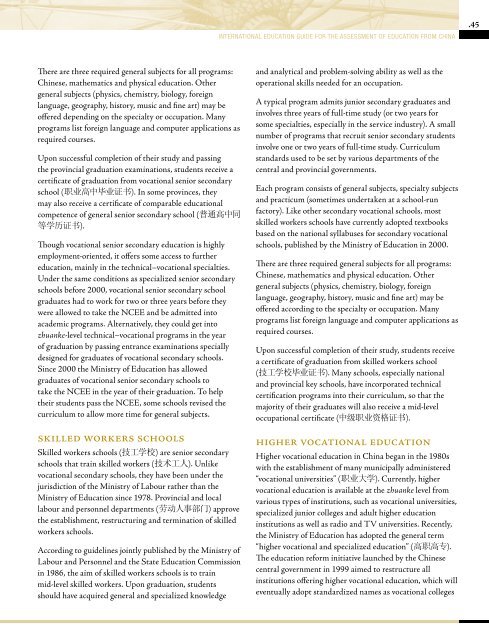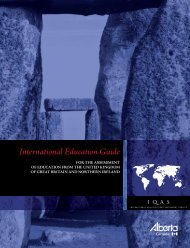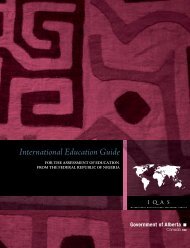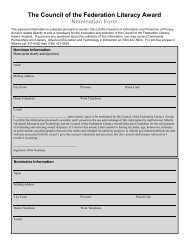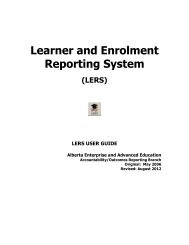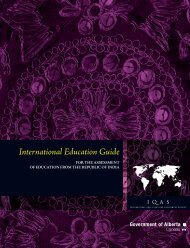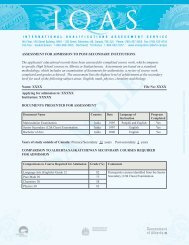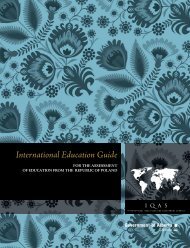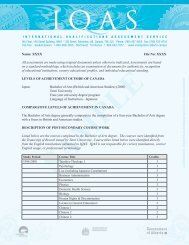International Education Guide - China - Enterprise and Advanced ...
International Education Guide - China - Enterprise and Advanced ...
International Education Guide - China - Enterprise and Advanced ...
You also want an ePaper? Increase the reach of your titles
YUMPU automatically turns print PDFs into web optimized ePapers that Google loves.
INTERNATIONAL EDUCATION GUIDE FOR THE ASSESSMENT OF EDUCATION FROM CHINA<br />
.45<br />
There are three required general subjects for all programs:<br />
Chinese, mathematics <strong>and</strong> physical education. Other<br />
general subjects (physics, chemistry, biology, foreign<br />
language, geography, history, music <strong>and</strong> fine art) may be<br />
offered depending on the specialty or occupation. Many<br />
programs list foreign language <strong>and</strong> computer applications as<br />
required courses.<br />
Upon successful completion of their study <strong>and</strong> passing<br />
the provincial graduation examinations, students receive a<br />
certificate of graduation from vocational senior secondary<br />
school ( 职 业 高 中 毕 业 证 书 ). In some provinces, they<br />
may also receive a certificate of comparable educational<br />
competence of general senior secondary school ( 普 通 高 中 同<br />
等 学 历 证 书 ).<br />
Though vocational senior secondary education is highly<br />
employment-oriented, it offers some access to further<br />
education, mainly in the technical–vocational specialties.<br />
Under the same conditions as specialized senior secondary<br />
schools before 2000, vocational senior secondary school<br />
graduates had to work for two or three years before they<br />
were allowed to take the NCEE <strong>and</strong> be admitted into<br />
academic programs. Alternatively, they could get into<br />
zhuanke-level technical–vocational programs in the year<br />
of graduation by passing entrance examinations specially<br />
designed for graduates of vocational secondary schools.<br />
Since 2000 the Ministry of <strong>Education</strong> has allowed<br />
graduates of vocational senior secondary schools to<br />
take the NCEE in the year of their graduation. To help<br />
their students pass the NCEE, some schools revised the<br />
curriculum to allow more time for general subjects.<br />
skilled workers schools<br />
Skilled workers schools ( 技 工 学 校 ) are senior secondary<br />
schools that train skilled workers ( 技 术 工 人 ). Unlike<br />
vocational secondary schools, they have been under the<br />
jurisdiction of the Ministry of Labour rather than the<br />
Ministry of <strong>Education</strong> since 1978. Provincial <strong>and</strong> local<br />
labour <strong>and</strong> personnel departments ( 劳 动 人 事 部 门 ) approve<br />
the establishment, restructuring <strong>and</strong> termination of skilled<br />
workers schools.<br />
According to guidelines jointly published by the Ministry of<br />
Labour <strong>and</strong> Personnel <strong>and</strong> the State <strong>Education</strong> Commission<br />
in 1986, the aim of skilled workers schools is to train<br />
mid-level skilled workers. Upon graduation, students<br />
should have acquired general <strong>and</strong> specialized knowledge<br />
<strong>and</strong> analytical <strong>and</strong> problem-solving ability as well as the<br />
operational skills needed for an occupation.<br />
A typical program admits junior secondary graduates <strong>and</strong><br />
involves three years of full-time study (or two years for<br />
some specialties, especially in the service industry). A small<br />
number of programs that recruit senior secondary students<br />
involve one or two years of full-time study. Curriculum<br />
st<strong>and</strong>ards used to be set by various departments of the<br />
central <strong>and</strong> provincial governments.<br />
Each program consists of general subjects, specialty subjects<br />
<strong>and</strong> practicum (sometimes undertaken at a school-run<br />
factory). Like other secondary vocational schools, most<br />
skilled workers schools have currently adopted textbooks<br />
based on the national syllabuses for secondary vocational<br />
schools, published by the Ministry of <strong>Education</strong> in 2000.<br />
There are three required general subjects for all programs:<br />
Chinese, mathematics <strong>and</strong> physical education. Other<br />
general subjects (physics, chemistry, biology, foreign<br />
language, geography, history, music <strong>and</strong> fine art) may be<br />
offered according to the specialty or occupation. Many<br />
programs list foreign language <strong>and</strong> computer applications as<br />
required courses.<br />
Upon successful completion of their study, students receive<br />
a certificate of graduation from skilled workers school<br />
( 技 工 学 校 毕 业 证 书 ). Many schools, especially national<br />
<strong>and</strong> provincial key schools, have incorporated technical<br />
certification programs into their curriculum, so that the<br />
majority of their graduates will also receive a mid-level<br />
occupational certificate ( 中 级 职 业 资 格 证 书 ).<br />
higher vocational education<br />
Higher vocational education in <strong>China</strong> began in the 1980s<br />
with the establishment of many municipally administered<br />
“vocational universities” ( 职 业 大 学 ). Currently, higher<br />
vocational education is available at the zhuanke level from<br />
various types of institutions, such as vocational universities,<br />
specialized junior colleges <strong>and</strong> adult higher education<br />
institutions as well as radio <strong>and</strong> TV universities. Recently,<br />
the Ministry of <strong>Education</strong> has adopted the general term<br />
“higher vocational <strong>and</strong> specialized education” ( 高 职 高 专 ).<br />
The education reform initiative launched by the Chinese<br />
central government in 1999 aimed to restructure all<br />
institutions offering higher vocational education, which will<br />
eventually adopt st<strong>and</strong>ardized names as vocational colleges


